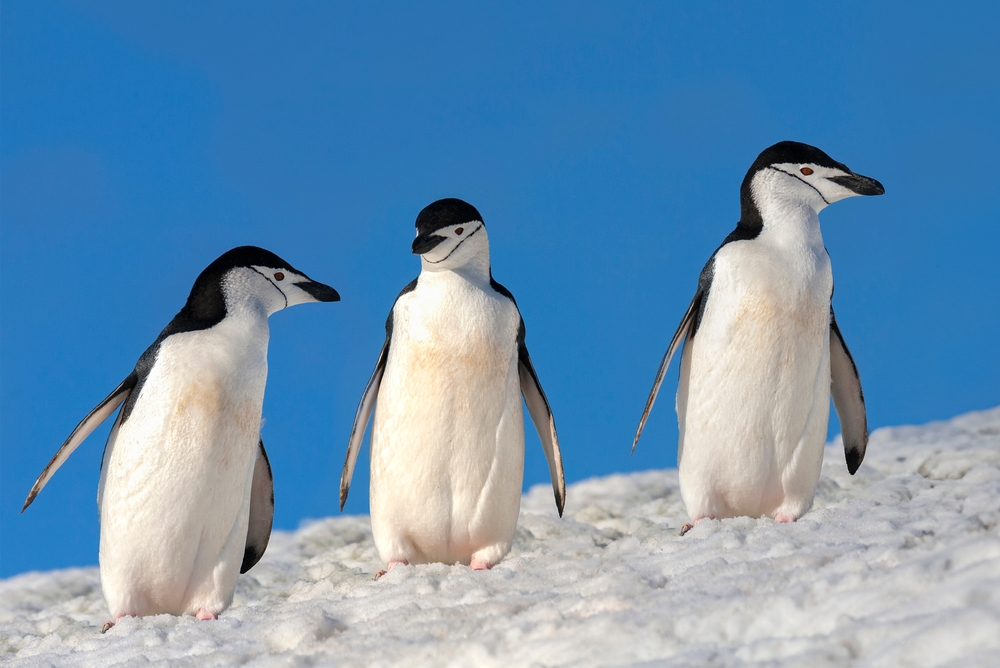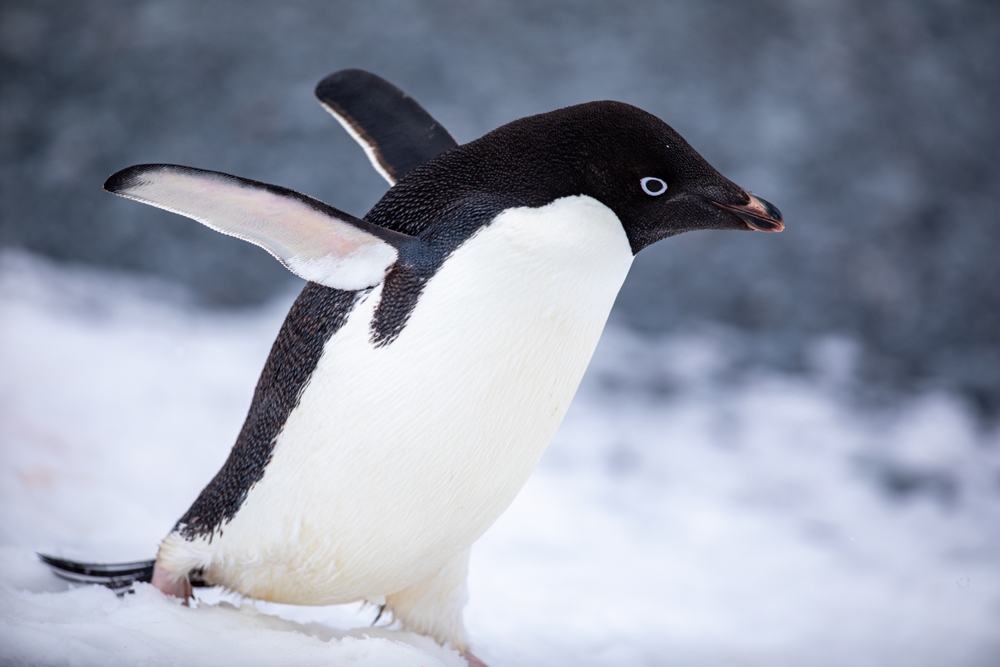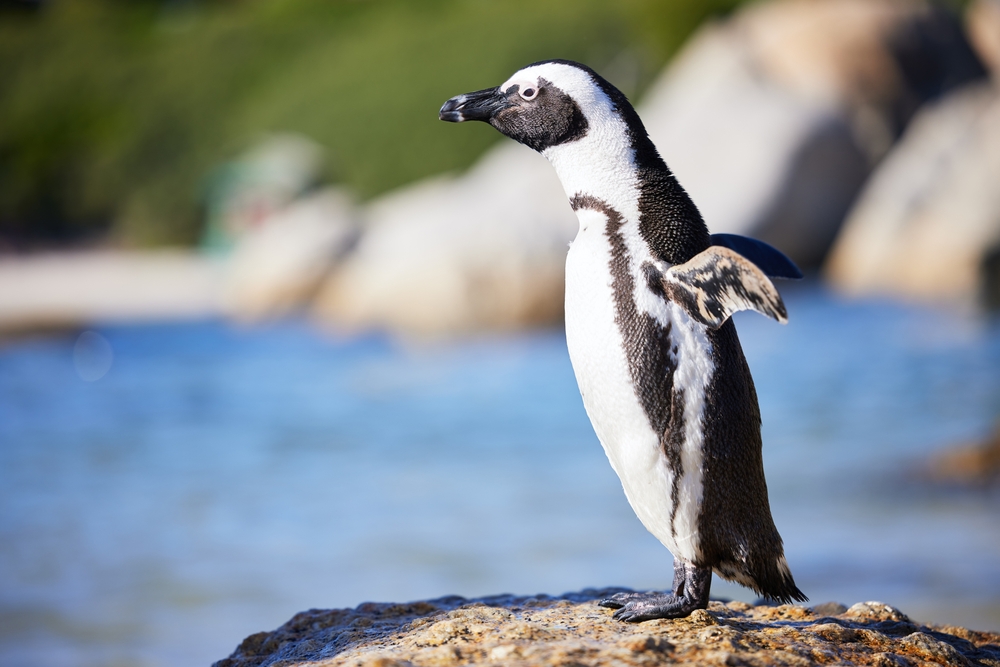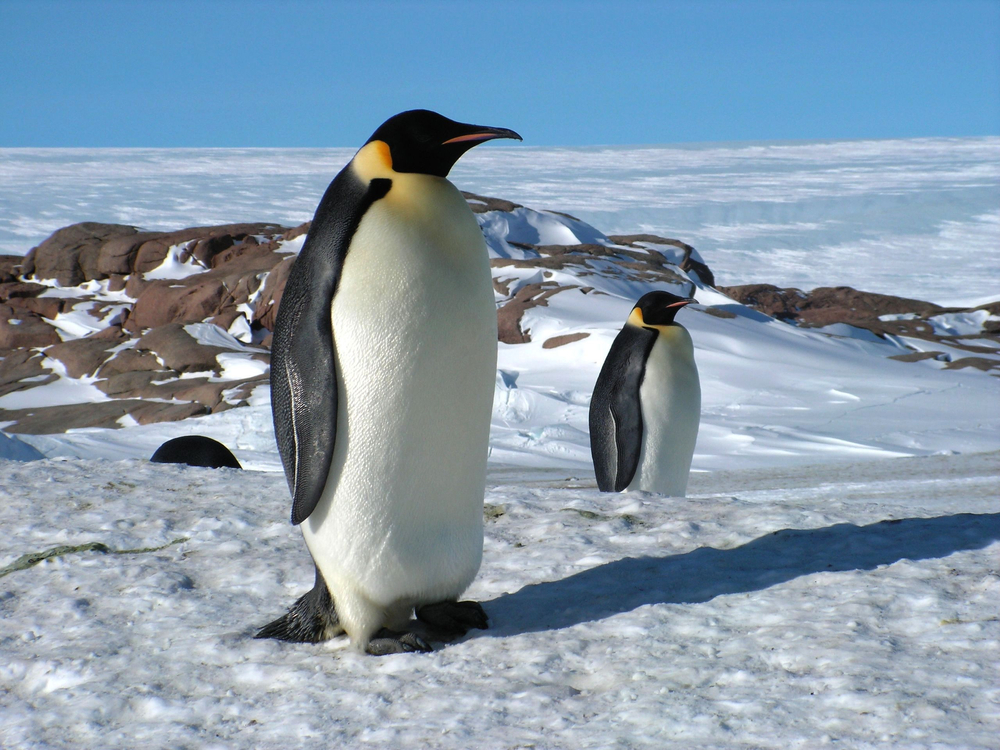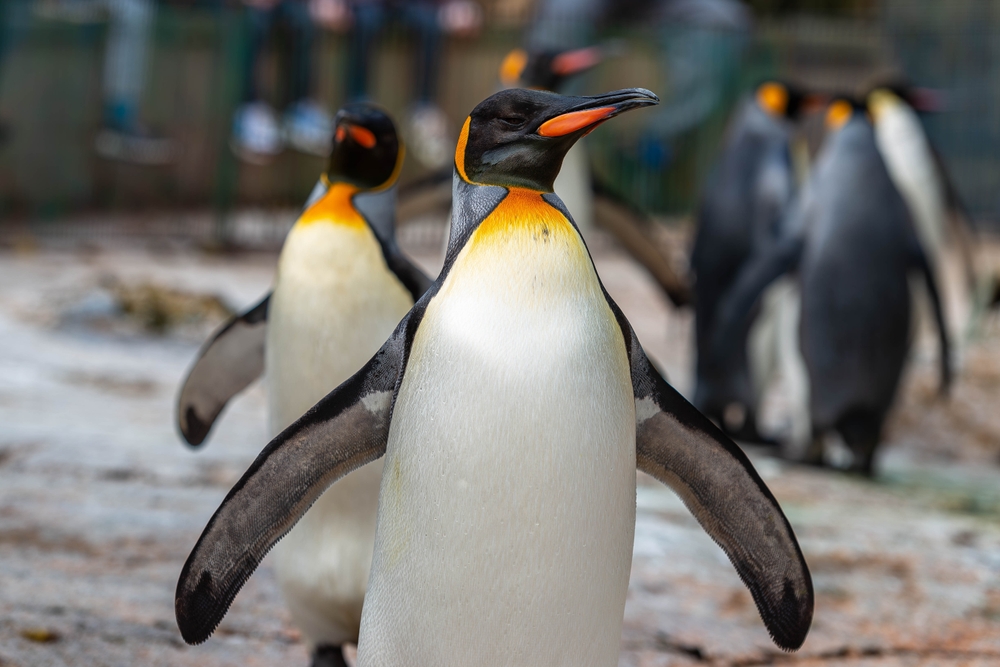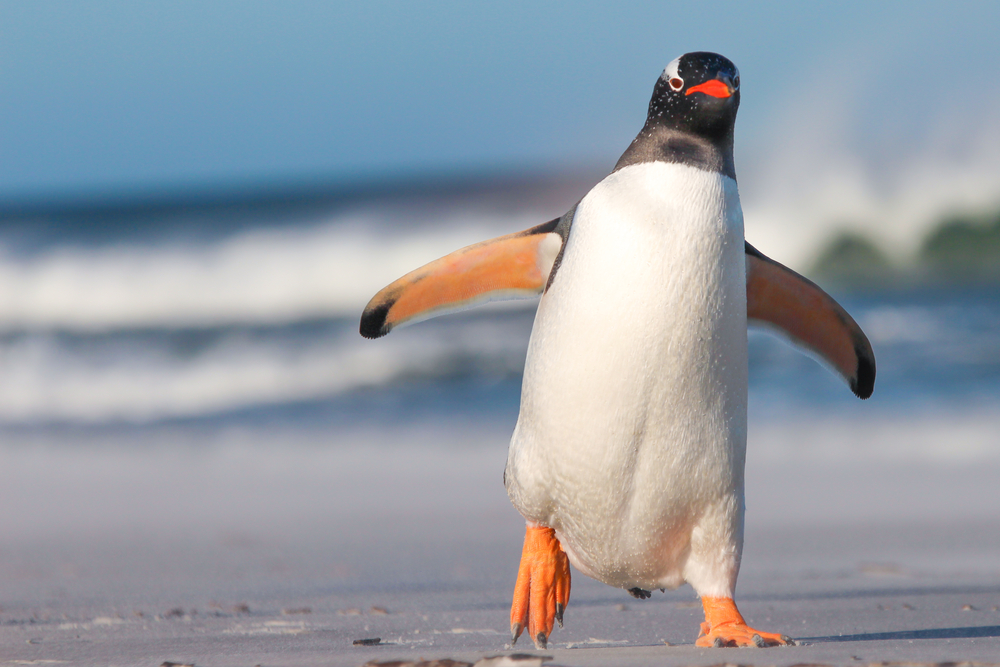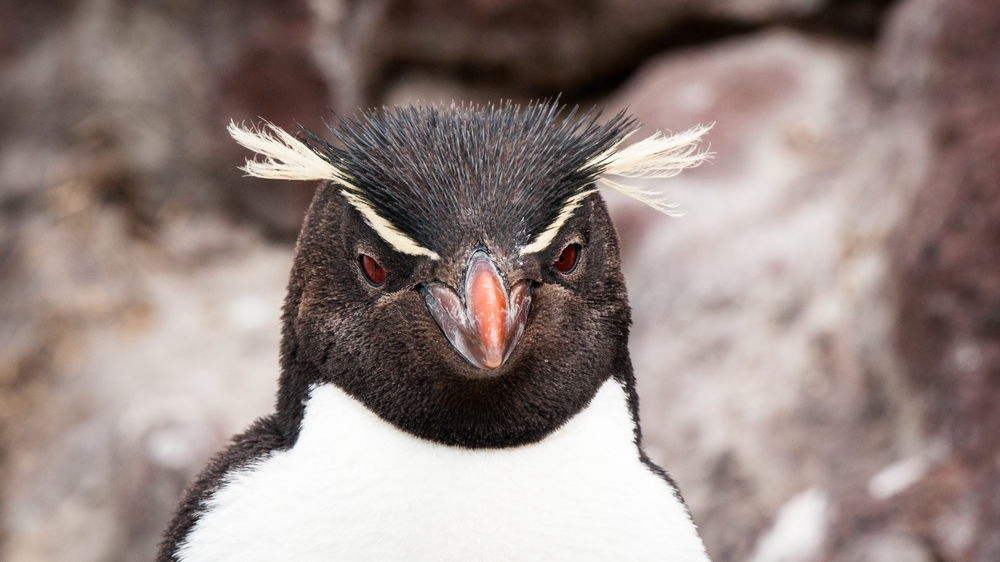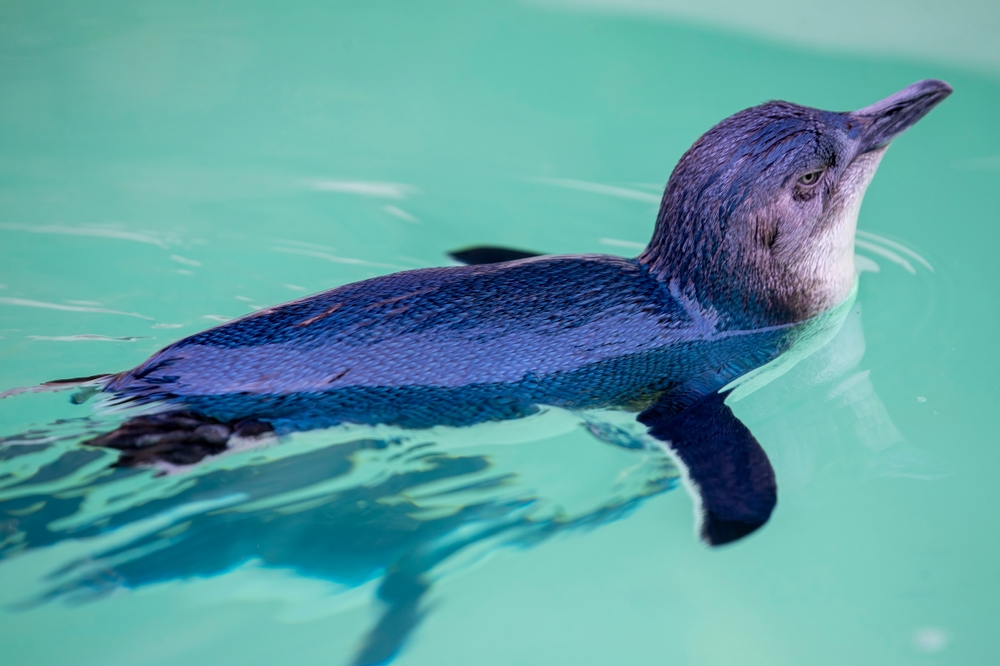The Chinstrap Penguin is most closely related to the Adélie Penguin and the Gentoo Penguin, its fellow members of the genus Pygoscelis. Together, they are known as the “brush-tailed penguins” because of their stiff, wedge-shaped tails.
About
The Chinstrap Penguin (Pygoscelis antarcticus) is a striking Antarctic seabird of the Spheniscidae family, named for the thin black line running from ear to ear beneath its chin, which looks like a helmet strap. Found mainly on the Antarctic Peninsula, South Sandwich Islands, South Shetlands, and other sub-Antarctic regions, it is one of the most abundant penguin species, with colonies numbering in the millions.
Chinstrap Penguins stand about 68 to 76 centimeters (27 to 30 inches) tall and weigh between 3 and 5 kilograms (7 to 11 pounds). Their bold black-and-white plumage creates a sharp contrast, with the unique “chinstrap” marking distinguishing them from Adélie and Gentoo Penguins. Their strong, slightly curved bills and pinkish feet further add to their distinctive appearance.
These penguins are exceptional swimmers, using their streamlined bodies to dart swiftly through the water at speeds up to 30 km/h (18 mph). Their diet is dominated by Antarctic krill, though they also consume fish and small squid. By feeding primarily on krill, Chinstrap Penguins play a central role in the Antarctic marine ecosystem.
Breeding occurs in vast colonies, often on rocky, ice-free slopes. Males build nests from stones, which are defended vigorously against neighbors. Females usually lay two eggs, and both parents share incubation and feeding duties. Chicks fledge after about two months, joining crèches for protection until they are strong enough to go to sea.
The species is currently listed as Least Concern, though populations are declining in some areas due to climate change and reductions in sea ice, which affect krill abundance.
With their bold markings, noisy colonies, and energetic swimming, Chinstrap Penguins embody the rugged and communal spirit of life in Antarctica.
Physical Characteristics
Chinstrap Penguins are medium-sized Antarctic penguins, easily identified by the narrow black line running under their chin, which gives the appearance of a helmet strap.
-
Coat/Plumage: They have a sharply contrasting black-and-white coloration. Their head, back, and flippers are black, while the face, chest, and belly are bright white. The thin black “chinstrap” across the throat is their most defining feature.
-
Face: The face is predominantly white with a small black bill. The eyes are reddish-brown, set against the stark facial contrast.
-
Body: Compact and stocky, built for insulation in polar environments. Their streamlined body allows efficient swimming and diving.
-
Flippers: Black above and white below, adapted as powerful paddles to propel them underwater.
-
Feet: Pinkish with strong black claws, aiding both in swimming and climbing rocky terrain.
-
Tail: Short, stiff, and wedge-shaped, used for balance when moving on ice.
Size:
-
Length (Body): Typically 27 to 30 in (68 to 76 cm).
-
Weight: Between 6.6 to 11 lbs (3 to 5 kg), with males slightly larger than females.
Chinstrap Penguins’ bold plumage and distinctive throat band make them one of the easiest penguin species to identify. Their strong build, waterproof plumage, and powerful flippers allow them to thrive in the icy waters of the Southern Ocean.
Reproduction
The reproductive cycle of Chinstrap Penguins is highly synchronized with the Antarctic summer and the availability of ice-free nesting grounds.
-
Mating and Courtship:
-
Chinstrap Penguins are generally monogamous, often reuniting with the same mate each breeding season.
-
Courtship involves vocal displays, mutual preening, and synchronized head movements to strengthen pair bonds.
-
Breeding season begins in late October to early November when adults return to their colonies.
-
-
Nesting:
-
They build nests from stones and pebbles, which help elevate the eggs above melting snow.
-
Nests are closely spaced in large colonies that may number in the tens of thousands.
-
-
Egg Laying and Incubation:
-
The female typically lays two eggs per season.
-
Both parents share incubation duties, alternating shifts of 5 to 10 days.
-
Incubation lasts around 37 days.
-
-
Chick Development:
-
Chicks hatch with soft gray down, weighing about 3–4 oz (85–115 g).
-
Parents brood the chicks constantly during the first few weeks, feeding them regurgitated food.
-
-
Crèche and Independence:
-
At about 3 to 4 weeks old, chicks gather in groups called crèches, gaining warmth and protection while both parents forage at sea.
-
Fledging occurs at around 7 to 9 weeks, when the chicks molt into waterproof feathers and begin life at sea.
-
Chinstrap Penguins’ synchronized breeding and shared parental care are crucial to chick survival in harsh polar conditions. Predation from skuas and severe weather remain the biggest threats to breeding success.
Lifespan
Chinstrap Penguins are hardy seabirds that thrive in the icy environments of the Southern Ocean. Their lifespan varies depending on conditions in the wild versus under human care.
-
Lifespan in the Wild:
Chinstrap Penguins typically live 15 to 20 years in their natural habitat. Survival depends heavily on food availability, predation, and environmental conditions such as sea ice and weather extremes. Juveniles face the highest mortality rates during their first year at sea. -
Lifespan in Captivity:
Though rarely kept in captivity due to their specialized environment needs, Chinstrap Penguins may live longer under proper care, sometimes exceeding 20 years.
Threats to the Chinstrap Penguin:
-
Climate Change: Shifts in sea ice and warming ocean waters affect the distribution of krill, their primary food source.
-
Predation: Eggs and chicks are vulnerable to skuas, sheathbills, and giant petrels, while leopard seals prey on adults at sea.
-
Food Scarcity: Competition with commercial fisheries and natural fluctuations in krill populations directly impact survival and breeding success.
-
Human Disturbance: Increasing tourism in Antarctica can disrupt nesting colonies if not carefully managed.
Conservation measures, including marine protected areas and strict Antarctic Treaty regulations, are vital for sustaining Chinstrap Penguin populations, which serve as indicators of ecosystem health in the Southern Ocean.
Eating Habits
Chinstrap Penguins are carnivorous seabirds that rely heavily on the abundant marine life of the Southern Ocean.
-
Diet:
Their primary food source is Antarctic krill, which makes up the majority of their diet. They also eat small fish and squid, particularly when krill availability is low. -
Foraging Strategy:
Chinstraps are efficient pursuit divers, using their flippers to propel themselves quickly through the water. They usually feed at depths of 100 to 200 ft (30 to 60 m), though they can dive deeper when needed. -
Hunting Behavior:
They often forage in groups, which increases efficiency by herding krill swarms or fish schools into dense clusters. Group foraging also provides safety in numbers against predators like leopard seals. -
Feeding the Young:
Parents carry food back in their stomachs and regurgitate partially digested krill and fish to feed their chicks at the nest. -
Seasonal Variation:
During breeding season, they feed close to colonies, focusing heavily on krill. Outside of breeding season, they may range farther at sea, adding more fish and squid to their diet.
Chinstrap Penguins’ dependence on krill makes them highly sensitive to environmental changes and commercial fishing pressures. Their feeding habits play a critical role in the Antarctic food web, linking primary producers to higher predators.
Uniqueness
The Chinstrap Penguin (Pygoscelis antarcticus) is one of the most easily recognized penguin species, with traits that make it stand out:
-
Distinctive “Chinstrap”: Their thin black band under the chin gives the appearance of a helmet strap, making them instantly recognizable.
-
Most Numerous Penguin: With an estimated population of over 8 million breeding pairs, they are the most abundant penguin species in Antarctica.
-
Vocal Colonies: Their breeding colonies are extremely loud and active, filled with harsh calls and constant social interaction.
-
Agile Climbers: Unlike many penguins, Chinstraps are skilled at climbing steep, icy slopes to reach nesting sites, using their claws and tails for balance.
-
Krill Specialists: They are highly dependent on Antarctic krill, making them a vital ecological link in the Southern Ocean food chain.
-
Synchronized Breeders: Entire colonies breed in close synchrony, which helps protect chicks from predators through sheer numbers.
-
Resilient Survivors: They can withstand extremely harsh Antarctic winters, returning each year to ice-free nesting grounds despite difficult terrain.
The Chinstrap Penguin’s combination of abundance, adaptability, and striking appearance makes it one of the most iconic and ecologically important penguin species in the Antarctic region.
Be the First to Share Photos of This Species.
FAQ’s
1. What is the species closest to the Chinstrap Penguin?
2. How does the Chinstrap Penguin compare to other penguins?
Chinstraps are medium-sized penguins, smaller than Emperor and King Penguins but larger than Little Blue Penguins. They are among the most abundant penguins, with highly vocal and crowded colonies. Their agility on steep, icy slopes and their distinctive throat strap set them apart from other species.
3. What national parks provide an opportunity to see the Chinstrap Penguin?
Chinstrap Penguins are found on the Antarctic Peninsula and nearby islands. Key protected areas where they can be observed include:
-
South Shetland Islands (Antarctic Specially Protected Areas) – home to massive Chinstrap colonies.
-
Antarctic Peninsula (various ASPAs under the Antarctic Treaty System) – important nesting sites.
-
South Orkney and South Sandwich Islands – breeding grounds under international conservation protection.
Tourists visiting Antarctica through regulated expeditions often encounter Chinstrap Penguins at colonies within these protected zones.



































































